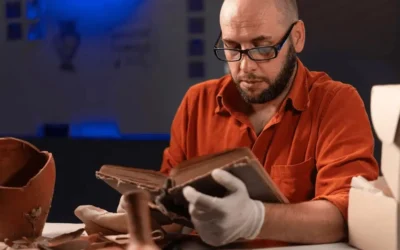Archival Security Basics
Margot Note
Natural threats are easy to identify and are relatively straightforward to mitigate; they include fire, floods, temperature and humidity fluctuations, insects, and dust.
Theft, Loss, and Neglect
However, human threats, like theft, loss, and neglect, are harder to manage. While trust is essential, archivists cannot screen staff members or researchers sufficiently to eliminate all threats. Staff members are, unfortunately, frequently responsible for theft. People steal for monetary reasons, impulse, sentiment, the fear that others are getting ahead in their research, the notion that they are only borrowing, and the desire to purge the historical record of damaging information.
Archivists, understandably, are reluctant to publicize losses of the historical record in general and even more so when the offender is a colleague. News of significant incidents usually occurs through the mass press, which further sullies the profession. Since the field is hesitant to talk about the problem, archivists are unaware of the full extent of it and are uninformed of the range of activities they may perform to curtail theft.
One way to look at security is to identify assets and threats in terms of public and restricted areas and to set up systems accordingly. Archivists at the department-head level, as well as administrators and managers with a level of authority, can then modify their procedures and policies to reduce opportunities for theft, loss, and neglect. Thus, security becomes a management issue rather than purely a preservation one.
Locking Down Locations
Stacks and storage areas should be separate from work or public spaces, with controlled access. Archivists should segregate valuable items in locked areas within the stacks. Items may also be removed from collections for separate storage with photocopies in place of the originals in the box. Some archives have a schedule for checking valuable items, making sure they’re still present.
Work areas contain furniture, equipment, and files. They have increased traffic and the presence of non-archivists. Because this area offers entry to a broad group of people, without the visibility of a reading room, access should be controlled and lockable.
In the reading room and other public areas, threats increase, especially if there are exhibits that bring in members of the public who haven’t gone through the researcher screening process. Archives control access, providing places for people to store their belongings, and a physical layout of the spaces that ensures good site lines.
Being Aware
Archivists also control what researchers have access to, limiting quantities, paying attention to the use of unprocessed or valuable material, and controlling times when items are out of the archives for preservation purposes or exhibition. The size of archival collections, as well as their description at the folder- or box-level, precludes item-by-item identification. Archivists rarely count every item before and after use, but selected files may require this activity.
Security concerns from a management perspective also mean controlling when maintenance people are in the areas, and making sure staff members know what to do in case of theft or emergencies, including knowing local laws, and the location of exits, alarms, and water valves.
Smart and Safe
Nothing is foolproof. A secure archives has administrative policies in place and presents an appearance of vigilance. Unfortunately, theft has plagued the keepers of irreplaceable documents for decades, and archival assets will always need security procedures. Using common sense, archivists can take concerted preventative measures to protect materials from the human threats from inside and outside the institution.
Margot Note
Margot Note, archivist, consultant, and author is a guest blogger for Lucidea, provider of ArchivEra, archival collections management software for today’s challenges and tomorrow’s opportunities. Read more of Margot’s posts here, and get your free copy of Margot’s book under the Lucidea Press imprint, Demystifying Archival Project Management: Five Essentials for Success
Similar Posts
Texas Archive of the Moving Image: Interview with the Digital Archivist
I recently interviewed Grace Muñoz about her work at the Texas Archive of the Moving Image. Her work on improving the discoverability of the multimedia collection is fascinating.
How to Conduct Comprehensive Archival Surveys
Conducting a comprehensive archival survey is critical to successfully managing archival collections.
Remembering History, Moving Forward Together, with ArchivEra
The Catholic Diocese of Arlington’s Director of Archives selected ArchivEra to manage their collections of historical and cultural significance, and strike a balance between security and access.
Unveiling Archival Impact
The transformative power of storytelling depends upon the strategic choices that top archival performers make and the shift from being record-keepers to change agents.




Leave a Comment
Comments are reviewed and must adhere to our comments policy.
0 Comments